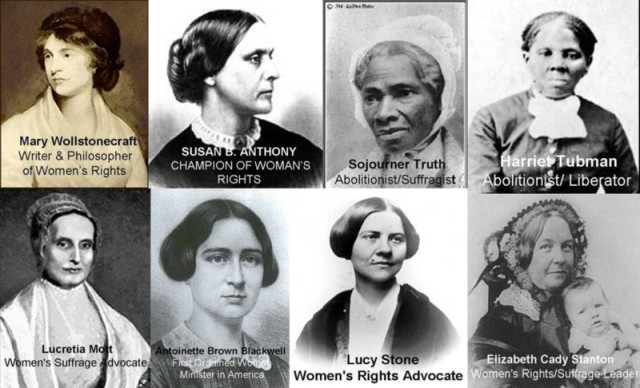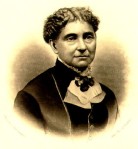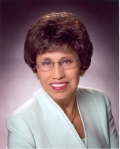
National Women’s History Month’s roots go back to March 8, 1857, when women from New York City factories staged a protest over working conditions. International Women’s Day was first observed in 1909, but it wasn’t until 1981 that Congress established National Women’s History Week to be commemorated the second week of March. In 1987, Congress expanded the week to a month. Every year since, Congress has passed a resolution for Women’s History Month, and the President has issued a proclamation.
In the early nineteenth century, women were considered second-class citizens whose existence was limited to the interior life of the home and care of the children. Women did not have the right to vote or own property, but they had to worked side by side with their husbands. On top of that, when they became widows the courts denied theirs inheritance. What a shame! Nineteenth century’s women had their self-confidence and self-respect destroyed and were expected to be willing to lead hopeless lives totally dependent on men.
Women activists trying to get the right to vote were called suffragists. The first woman’s rights convention was in Seneca Falls, N. Y. in 1848. The Seneca Falls convention brought together two hundred women and forty men, including the organizer feminist Elizabeth Cady Stanton. She included in the Declaration of Sentiments and Resolutions a right to suffrage (that is, to vote), and it was not even taken seriously. The Seneca Falls Declaration of Sentiments began with these words: “We hold these truths to be self-evident: that all men and women are created equal”. One of the main leaders of the women’s suffrage movement was Susan B. Anthony. In 1869, Anthony and Stanton organized the National Woman Suffrage Association (NWSA) to work for a federal constitutional amendment, guaranteeing all American women the right to vote. It would take 72 years after that first women’s rights convention before women were allowed to vote. In that time, many individuals would crusade for women’s right to vote. Victory came in the form of a constitutional amendment.
International Women’s Day is a time for women around the world to commemorate their struggles and celebrate their achievements. This International event on March 8th provides an opportunity to women across the world that is divided by culture, language, and social barriers to unite as a whole about the struggles they all face. Women’s History Month officially started in March 2000 by order of President Clinton when he signed a presidential proclamation highlighting women of the past and future.
 Amelia Jenks Bloomer (1818-1894) Social reformer, suffragist, and publisher of the temperance paper The Lily. She was born in Homer, New York, in 1818. Though she herself was only formally-educated for two years, she taught school and was thought remarkably intelligent by her peers. At age twenty-two, in 1840, she married lawyer Dexter Bloomer. By his encouragement, Amelia began writing articles in support of prohibition and women’s rights for his paper, The Seneca Falls Courier. Her interests led her to join several temperance groups and women’s rights organizations in the Seneca Falls area, even taking her to the famous Seneca Falls Convention in 1848.
Amelia Jenks Bloomer (1818-1894) Social reformer, suffragist, and publisher of the temperance paper The Lily. She was born in Homer, New York, in 1818. Though she herself was only formally-educated for two years, she taught school and was thought remarkably intelligent by her peers. At age twenty-two, in 1840, she married lawyer Dexter Bloomer. By his encouragement, Amelia began writing articles in support of prohibition and women’s rights for his paper, The Seneca Falls Courier. Her interests led her to join several temperance groups and women’s rights organizations in the Seneca Falls area, even taking her to the famous Seneca Falls Convention in 1848.
 Antoinette Louisa Brown (1825-1921) ¬ Social reformer, abolitionist and suffragist, she was the nation’s first ordained female minister, one of the first American women to attend college, and an author of books on evolution and social theory. She was born May 20, 1825, in Henrietta, New York, the seventh of Abigail Morse and Joseph Brown’s ten children. The family had a strong religious tradition. Together they frequented the Protestant revivals of Charles Grandison Finney in Rochester, New York. Blackwell’s pious leanings were evident at an early age when the nine-year old girl asked to become a member of the family’s Congregational Church. As Blackwell’s faith grew, her mother and minister encouraged her to become a foreign missionary. Even though such a profession was unheard-of for a young woman at that time, Blackwell harbored the dream of becoming a minister.
Antoinette Louisa Brown (1825-1921) ¬ Social reformer, abolitionist and suffragist, she was the nation’s first ordained female minister, one of the first American women to attend college, and an author of books on evolution and social theory. She was born May 20, 1825, in Henrietta, New York, the seventh of Abigail Morse and Joseph Brown’s ten children. The family had a strong religious tradition. Together they frequented the Protestant revivals of Charles Grandison Finney in Rochester, New York. Blackwell’s pious leanings were evident at an early age when the nine-year old girl asked to become a member of the family’s Congregational Church. As Blackwell’s faith grew, her mother and minister encouraged her to become a foreign missionary. Even though such a profession was unheard-of for a young woman at that time, Blackwell harbored the dream of becoming a minister.
 Emma Goldman (1869-1940), is one of history’s great rebels. An anarchist and prolific writer and lecturer, she led strikes, planned for revolution, and espoused sexual freedom. Her essays scoff at the idea that woman suffrage would eliminate corruption or help women find emancipation. They also focus attention on the economic basis of prostitution and espoused women’s rights to birth control at a time when disseminating information about contraception violated obscenity laws.
Emma Goldman (1869-1940), is one of history’s great rebels. An anarchist and prolific writer and lecturer, she led strikes, planned for revolution, and espoused sexual freedom. Her essays scoff at the idea that woman suffrage would eliminate corruption or help women find emancipation. They also focus attention on the economic basis of prostitution and espoused women’s rights to birth control at a time when disseminating information about contraception violated obscenity laws.
 Linda Chavez-Thompson, executive vice president of the AFL-CIO since 1995, is the first person of color to hold an executive office of that union. The daughter of Mexican American sharecroppers, Chavez-Thompson worked as an agricultural laborer and then served as a union representative and translator. She rose through the ranks at AFSCME, becoming vice president in 1988, before being hired by the AFL-CIO. She also serves as the vice chairperson of the Democratic National Committee.
Linda Chavez-Thompson, executive vice president of the AFL-CIO since 1995, is the first person of color to hold an executive office of that union. The daughter of Mexican American sharecroppers, Chavez-Thompson worked as an agricultural laborer and then served as a union representative and translator. She rose through the ranks at AFSCME, becoming vice president in 1988, before being hired by the AFL-CIO. She also serves as the vice chairperson of the Democratic National Committee.



























The early years of the 20th century were a time of great change in the United States. Women became increasingly active in the quest for their own suffrage. Though, in some countries, such as Saudi Arabia, there is no suffrage at all, and in others, such as Kuwait, it is very limited and excludes women completely.
The world is gradually changing. With the growing dominance of women leaders globally, the world seems to be recognizing the power of women finally!
Pingback: 425 ta-rang-wa. | bimbalo
Reblogged this on Ganja Vibes.